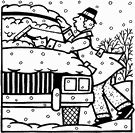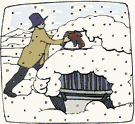The three key elements to safe winter driving are:
Stay alert;
Slow down; and
Stay in control
It is best to winterize your vehicle before winter strikes. Schedule a maintenance check-up for the vehicle’s tires and tire pressure, battery, belts and hoses, radiator,oil, lights, brakes, exhaust system, heater/defroster, wipers and ignition system.Keep your gas tank sufficiently full – at least half a tank is recommended. Depending Upon where you drive, you may consider using winter tires or tire chains.
Winter driving conditions such as rain, snow, and ice dramatically affect the braking distance of a vehicle. The driver’s capability to complete a smooth and safe stops severely limited due to reduced tire traction. In order to stop safely, the vehicle’s wheels must maintain traction by remaining on contact with the road surface while rolling, referred to as “rolling traction.” When handling slippery winter roads,the keys to safety are slower speeds, gentler stops and turns, and increased following distances. It is recommended that drivers reduce their speed to half the posted speed limit or less under snowy road conditions.
Don’t try to stretch more miles from your tires during the winter months. If your tread depth is getting low, it can have serious effects on dry pavement, but those effects are multiplied in wet and snowy conditions. When in doubt, get new tires.
Tire pressure usually lowers itself in winter and raises itself in summer. Under-inflated tires can cause a car to react more slowly to steering. Every time the outside temperature drops ten degrees, the air pressure inside your tires goes down about one or two PSI. Tires lose air normally through the process of permeation. Drivers should check their tire pressures frequently during cold weather, adding enough air to keep them at recommended levels of inflation at all times.
Sand and salt play a big role in keeping roads safe. The spreading of road salt prevents snow and ice from bonding to the road surface, which is why salt is usually spread early in a storm to prevent snow build-up and to aid in snow removal operations.
Unlike salt, sand does not melt and therefore helps by providing traction on slippery surfaces. Sand is often used when temperatures are too low for salt to be effective at higher temperatures for Immediate Extraction, particularly on hills, curves,bridges, intersections and on snow-packed roads.
Caution must be used when snow plows are on the roadways as snowplows and salt and sand trucks travel much slower than regular traffic. Passing a snowplow can be extremely dangerous as sight lines and visibility near a working snowplow are severely restricted by blowing snow.
Roads Are typically cooler in shady areas and drivers may encounter another extremely dangerous element known as “black ice.” Always slow down your vehicle when you see shady areas under these types of conditions.
Properly clean off your windshield - Adding Aqupel or a ceramic coating to your glass can help get snow and ice off your windshield - and using washer fluid for below -20 degrees is preferable. don't use cans or the like that can scratch your glass.
Stay home. Only go out if necessary. Even if you can drive well in bad weather, it’s better to avoid taking unnecessary risks by venturing out.
Drive slowly. Always adjust your speed down to account for lower traction when driving on snow or ice.
Accelerate and decelerate slowly. Apply the gas slowly to regain traction and avoid skids. Don’t try to get moving in a hurry and take time to slow down for a stoplight. Remember: It takes longer to slow down on icy roads.
Increase your following distance to five to six seconds. This increased margin of safety will provide the longer distance needed if you have to stop.
Know your brakes. Whether you have antilock brakes or not, keep the heel of your foot on the floor and use the ball of your foot to apply firm, steady pressure on the brake pedal.
Don’t stop if you can avoid it. There’s a big difference in the amount of inertia it takes to start moving from a full stop versus how much it takes to get moving while still rolling. If you can slow down enough to keep rolling until a traffic light changes, do it.
Don’t power up hills. Applying extra gas on snow-covered roads will just make your wheels spin. Try to get a little inertia going before you reach the hill and let that inertia carry you to the top. As you reach the crest of the hill, reduce your speed and proceed downhill slowly.
Don’t stop going up a hill. There’s nothing worse than trying to get moving up a hill on an icy road. Get some inertia going on a flat roadway before you take on the hill.
Drive with your lights on - daytime running lights are great but your tail lights are not visible- so manually turn on your lights .
Use a lower gear to provide more traction. Your vehicle will be less likely to accelerate quickly if it begins to slide on an icy road if it is being driven in a lower gear. Never use cruise control in winter weather conditions.



